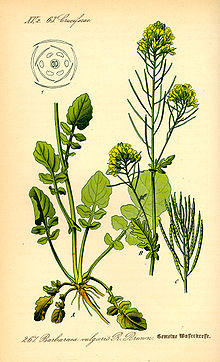| Barbarea | |
|---|---|
 | |
| Barbarea vulgaris | |
| Scientific classification | |
| Kingdom: | Plantae |
| Clade: | Tracheophytes |
| Clade: | Angiosperms |
| Clade: | Eudicots |
| Clade: | Rosids |
| Order: | Brassicales |
| Family: | Brassicaceae |
| Genus: | Barbarea W. T. Aiton |
Barbarea (winter cress or yellow rocket) is a genus of about 22 species of flowering plants in the family Brassicaceae, native to temperate regions of the Northern Hemisphere, with the highest species diversity in southern Europe and southwest Asia. They are small herbaceous biennial or perennial plants with dark green, deeply lobed leaves and yellow flowers with four petals.
Selected species
- Barbarea australis
- Barbarea balcana
- Barbarea bosniaca
- Barbarea bracteosa
- Barbarea conferta
- Barbarea hongii
- Barbarea intermedia
- Barbarea lepuznica
- Barbarea longirostris
- Barbarea orthoceras
- Barbarea rupicola
- Barbarea sicula
- Barbarea stricta
- Barbarea taiwaniana
- Barbarea verna
- Barbarea vulgaris
Uses
They grow quickly into dandelion-like rosettes of edible, cress-like foliage. Barbarea verna, also known as upland cress, early winter cress, American cress, Belle Isle cress and scurvy grass, is used in salads or to add a nippy taste to mixed greens for cooking.
Chemical compounds
Winter cress contains different glucosinolates, flavonoids and saponins.[1][2][3]
References
- ^ Vera Kuzina; Jens Kvist Nielsen; Jörg Manfred Augustin; Anna Maria Torp; Søren Bak; Sven Bode Andersen (2011). "Barbarea vulgaris linkage map and quantitative trait loci for saponins, glucosinolates, hairiness and resistance to the herbivore Phyllotreta nemorum". Phytochemistry. 72 (2–3): 188–198. doi:10.1016/j.phytochem.2010.11.007. PMID 21130479.
- ^ Lea Dalby-Brown; Carl Erik Olsen; Jens Kvist Nielsen; Niels Agerbirk (2011). "Polymorphism for novel tetraglycosylated flavonols in an eco-model crucifer, Barbarea vulgaris". Journal of Agricultural and Food Chemistry. 59 (13): 6947–6956. doi:10.1021/jf200412c. PMID 21615154.
- ^ Niels Agerbirk & Carl Erik Olsen (2011). "Isoferuloyl derivatives of five seed glucosinolates in the crucifer genus Barbarea". Phytochemistry. 72 (7): 610–623. doi:10.1016/j.phytochem.2011.01.034. PMID 21354584.
External links
- Flora Europaea: Barbarea
- Flora of China: Barbarea
 Data related to Barbarea at Wikispecies
Data related to Barbarea at Wikispecies